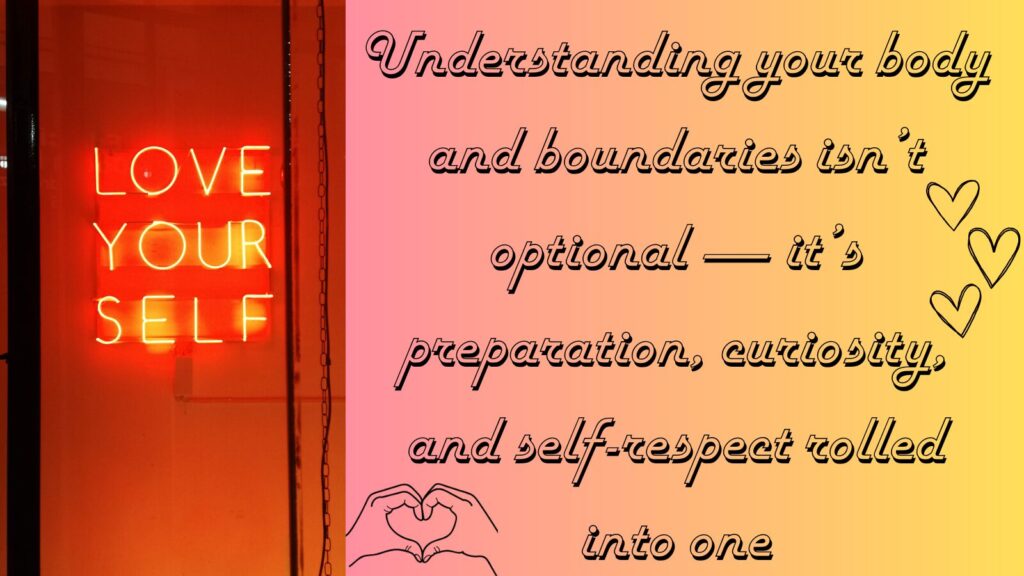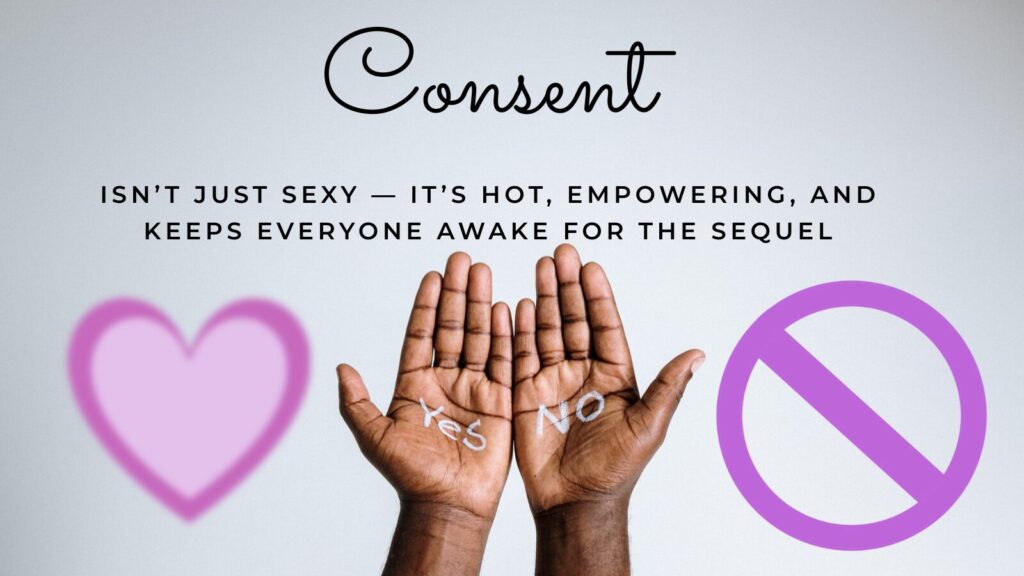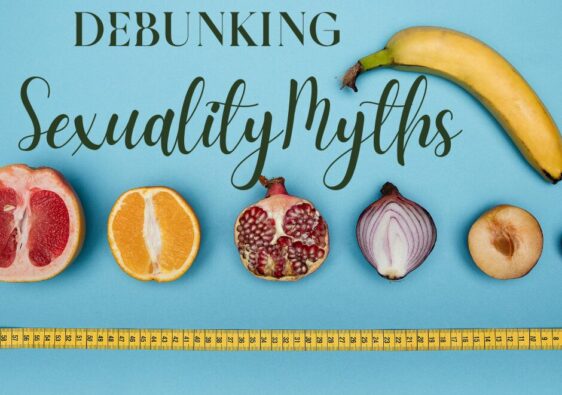Sex comes with a lot of free advice — most of it terrible. We’ve all heard the classics: men are always in the mood, erections are nature’s green light, penetration should last forever, and sex ed is only for active members. Oh, and apparently asking for consent isn’t sexy. These ideas sound familiar — and completely wrong. In this post, we’re clearing up some of the most common myths about desire, consent, and performance, and replacing them with what actually helps people have great, healthy sex.
Myth 1: Sex = Penetration

Many of us were taught — directly or indirectly — that sex starts with penetration and ends when someone (usually the man) ejaculates. But sex isn’t a single act. It’s an ecosystem.
Touching, kissing, oral sex, mutual masturbation, shared fantasies, using toys, sensual massage, and emotional intimacy — these are not just “foreplay” or side dishes. They are sex. And for some people, they’re the main course. For others, penetration isn’t desired at all, whether due to preference, identity, trauma, disability, or something else. And yet these other kinds of connections can be deeply satisfying and deliciously erotic. Just like anything else that makes both people feel connected and turned on. In short: if it makes you both smile, gasp, or melt a little, it counts.
Reducing sex to penetration erases the full landscape of pleasure. If pleasure were geography, then calling only penetration “real sex” is like saying Earth is just Ohio. Sex has been edited like a bad movie: climax first, character development later — or never. Because nothing says “shared experience” like racing to one person’s finish line while the other is still stretching. But, as Emily Nagoski puts it in Come As You Are, “Pleasure is the measure.” Not penetration. Let’s retire the idea that there’s only one way to have “real sex.” This isn’t a Hollywood script. It’s a human experience.
Myth 2: If You Have an Erection, You Want Sex

Ah, the classic: blood moves south and the whole man is on trial. Let’s be very clear — an erection is a blood flow thing. A reflex. Sometimes, a glitch in the system. It can happen because of desire. It can also happen because of stress, fear, bladder pressure, REM sleep, or that one time when the school nurse touched your arm and your body threw a party no one wanted to attend. Just because the lights are on doesn’t mean anyone’s home — or invited you in.
Let’s say it loud and clear: having an erection does not mean someone wants sex.
It doesn’t always mean they’re aroused. It doesn’t mean they’re consenting. It doesn’t mean they “liked it.” That myth is not only incorrect — it’s dangerous, because it weaponizes sexual assault cases to shame and silence victims. Studies have shown that physiological arousal (erections, lubrication, etc.) does not always match subjective arousal — that is, what a person is mentally feeling. This is called arousal non-concordance (see: Chivers et al., 2010). Let’s sum it up: just because your body stood up doesn’t mean it spoke on your behalf.
Myth 3: Men are always up for sex.

We’ve all heard the classic: “Men are always ready for sex and want it more.” Ah, yes, the idea that all men are roaming the world like hungry Labradors, permanently on the brink of humping the nearest leg. Cute, but wrong. Also, if you heard this about Labradors, that is wrong too.
So, there are studies — like Baumeister et al.’s (2001) big review — that show men, on average, report higher sexual desire than women. But here’s the kicker: “on average” doesn’t mean all the time, and it certainly doesn’t mean all men. What is often dismissed is that Baumeister points out that culture and social pressure shape those numbers. Men are told to brag about their libido, women are told to zip it, and suddenly the ‘gap’ starts resembling social norms dressed up as science.
And when you actually watch desire in real life (ethically — through diary studies, not binoculars), you see the truth: men’s libido isn’t a one-way elevator going up all day. Stress? It drops. Relationship tension? Same. Bad burrito the night before? You guessed it — romance is on hold. Murray et al. (2017) even found that in newlyweds, desire bounced around for both partners depending on how the relationship was doing, not just whether someone had a Y chromosome.
The whole “men are always ready for sex” myth isn’t just wrong — it’s also pretty cruel. If a man isn’t in the mood, instead of being treated like a human with normal ebbs and flows in desire, he can get shamed, humiliated, or told something’s “wrong” with him. Because heaven forbid a man prefers Netflix and soup over naked acrobatics for once.
And on the flip side, women get caught in a nasty spiral of insecurity if their male partner isn’t initiating. We’ve been sold the idea that men will always want us — so if he doesn’t, it must mean we’ve lost our looks, our spark, or our worth. Spoiler: it usually means nothing of the sort. Sometimes the guy’s tired. Sometimes he’s stressed. Sometimes he’s just… not in the mood.
Bottom line? These stereotypes don’t just warp the truth — they set both men and women up for shame, doubt, and awkward conversations that could be avoided if we all just admitted the obvious: sexual desire is not on a gendered schedule. The only constant? Sometimes Netflix just wins.
So, the next time you hear “men are always horny, feel free to roll your eyes like you’re attending the funeral of common sense. It’s not biology—it’s cultural scripting, social desirability, and just dumb math. Desire is human, not gendered.
Myth 4: Penetration Should Last a Long Time

There’s this fantasy — probably born somewhere between porn scripts and locker-room bravado — that good sex should last forever. Or at least 30 minutes. Or at least until the neighbors call the police. It’s gotta be long, wild, marathon stuff — preferably involving at least one pulled muscle and the risk of structural damage.
But science disagrees. Most studies, from the classic Waldinger stopwatch experiment in 2005 to recent reports in 2024, show that penetration lasts about 5 to 6 minutes on average before ejaculation. That’s quicker than it takes to open a bottle of wine and decide you’re better off with Netflix.
Five minutes. That’s not dysfunction. That’s not failure. That’s biology. That’s literally how human bodies often work. And it says nothing about how good the sex is.
Sure, penetration can be timed — but that would be as reliable as a haunted microwave: beeping loudly but still leaving your lasagna cold in the middle. You can last all night and still completely miss each other, but it only takes one touch or kiss to flip the whole script. Because time only tracks motion — it doesn’t capture meaning.
And Pleasure? Pleasure doesn’t even wear a watch. It doesn’t follow a schedule. It’s measured by presence, connection, and how many times you almost fell off the bed laughing, not how long you managed to ignore your leg cramp.
And let’s not forget — 70-80 percent of women don’t orgasm from penetration alone (see: literally every major sex study ever, but especially Herbenick et al., 2018; Frederick et al., 2017).
Also, the idea that “lasting longer = better lover” only fuels anxiety. The best lovers aren’t time travelers — they’re communicators, explorers, and people who care about how you feel, not just whether they beat some imaginary Olympic sex record.
Myth 5: If you are not having sex, you don’t need sexual education

This one is just silly. By that logic, you don’t need to learn about nutrition unless you’re a chef, or take a first-aid class unless you plan to be stabbed. Sex education is not a how-to manual for intercourse. It’s about understanding your body, setting boundaries, recognizing manipulation, respecting identities, valuing pleasure, knowing what a clitoris is, and maybe learning that asexual people exist, and are not broken or tragic or waiting for you to “fix” them.
Studies agree that individuals who receive comprehensive sex education are better at negotiating safer sex practices and communicating boundaries. So, turns out, people who understand how condoms work are less likely to treat them like party balloons.
If you’ve got a body, a heart, a brain, or the internet, you need sex education even if you’re not having sex. Especially then. Because a world without sex education is a world where people don’t know how to say no, or yes, or “please slower,” or “that’s not okay,” or “holy shit, this can actually feel good?” Sex or no sex, we all deserve at least one “holy shit.”
Myth 6: Consent is not sexy; it ruins the atmosphere

Let’s be honest: we grew up in a world where consent was more of a whispered myth than a practiced ritual. So it’s no wonder many feel that asking “Is this okay?” kills the mood — it’s unfamiliar territory. But think of times sneaking off to the bathroom to pee, because, well, infections aren’t sexy either; or those accidental fart noises when skin rubs together, because bodies are messy; or wiping with a soggy napkin after sex that’s clearly not up to the job; or that desperate hunt for your missing underwear — like it vanished into a mysterious black hole where all single socks g; and, of course, digging around for a lost condom in, well… places you did not want to loose it. (Okay, maybe that last one is less common, but definitely real.) None of those things screams sexy, but we accept them because we’re used to them. Meanwhile, stopping to ask for consent feels like it’s breaking the rhythm.
But here’s the kicker: in BDSM communities, consent isn’t a suggestion — it’s the foundation, the non-negotiable rule. You break that, you’re out. Nobody’s there rolling their eyes and whispering “buzzkill.” Why? Because when everyone’s clear, respected, and safe, the play gets way hotter, the trust deeper. Scientific studies back this up — consensual communication lights up reward centers in the brain, intensifies pleasure, and deepens connection (Ménard & Offerman, 2012; Muise et al., 2017). Consent isn’t the opposite of sexy; it creates the atmosphere where real desire can thrive.
So if wiping, prepping toys, or awkward condom hunts don’t kill the mood, neither does asking, “Is this okay?” It’s time we made consent the sexy new habit — the one that turns sex from a guessing game into a shared, electric experience.
Myth 7: The Female body stores the DNA of its sexual partners

You know that tired stereotype some guys love to trot out? The one where women supposedly “keep the DNA” of every man they sleep with, like some biological souvenir collection. This one hits personal for me, because I’ve heard that gem more times than I care to count—mostly from sexist exes trying to sound like scientists. Spoiler alert: it’s complete and utter nonsense.
This myth actually stems from a misinterpretation of studies on microchimerism — a phenomenon where tiny amounts of fetal DNA remain in the mother’s body long after pregnancy (Bianchi, 2012). Somehow, this got wildly twisted into the idea that women store DNA from all their sexual partners. Even the lead researcher, Dr. Diana Bianchi, clarified that the findings relate specifically to fetal cells transferred during pregnancy and do not support the notion that women accumulate DNA from consensual partners through sex (Bianchi, 2014).
There’s zero evidence that sexual partners’ DNA hangs out in women’s bodies like a permanent guest list. It’s just a creepy myth designed to shame women and control their sexuality by turning biology into a horror story. So, if someone tries to pull that stunt, feel free to hand them a biology textbook—or just show them the door.
So much for the old rulebook. Men don’t always want sex, women aren’t secret DNA archives, erections aren’t contracts, and long penetration isn’t the gold standard of good sex. If you’re still holding onto these myths, it’s time to let them go — they’re as accurate as a weather app from 2003. When we stop chasing someone else’s definition of ‘good sex,’ we finally get to write our own.




